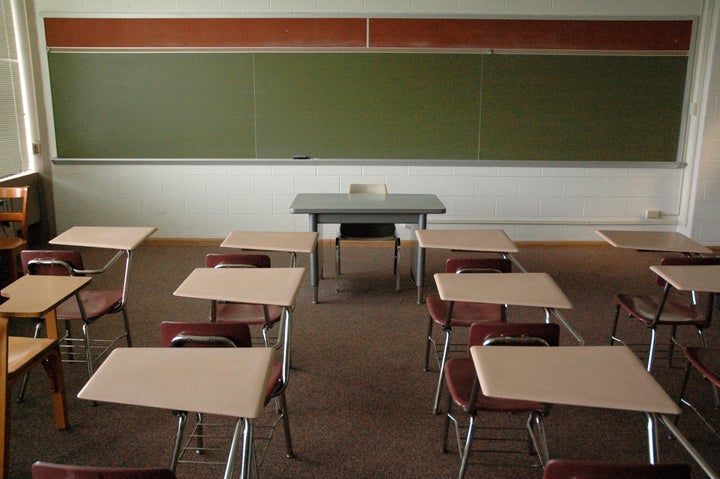
In Florida, the state's Senate Education Committee recently forwarded a bill on school prayer to state lawmakers for consideration. Proposed by Democratic Sen. Gary Siplin of Orlando, the bill would allow student-led prayers at school events like graduation, dances and football games. Since the U.S. Supreme Court banned prayer and other devotional activities in public schools in the early 1960s, dozens of states have circumvented the law by passing legislation similar to that proposed in Florida this month. In the decades-old battle over prayer in schools, the media and politicians alike have painted the scuffle as an intransigent standoff between secular atheists and religious traditionalists. But the history of school prayer reveals that religious Americans have often been at the forefront of keeping prayer out of the nation's public schools.
Long before the Supreme Court declared school prayer as unconstitutional in the 1962 decision Engel v. Vitale, religious devotion and instruction in public schools remained a controversial issue among people of faith. Nineteenth century Catholics objected to the Protestant prayers and hymns their children had to recite each morning, and they opposed the use of the King James Bible for Scripture lessons because canon law prohibited Catholics from reading that translation. Many Catholics removed their children from the public school system in favor of Catholic private schools for just this reason, but those left behind often suffered brutally. In Boston, for example, school officials severely beat a young Catholic boy who refused to recite the Protestant version of the Ten Commandments in 1859.
A century later when the Supreme Court outlawed public school prayers and devotionals, many states had already banned the practice. Still, the Court's decision sent shock waves through the country. But religious leaders, especially from evangelical corners, expressed mixed sentiments. Prominent pastors like Billy Graham and Billy James Hargis denounced the ruling, but the Southern Baptist Convention's president hailed the decision as "one of the greatest blessings to those of us who believe in the absolute separation of church and state." The National Association of Evangelicals and Christianity Today, the nation's leading evangelical publication, both supported the Court's ruling as well, citing the First Amendment.
Of course, many evangelicals and other religious Americans believed the Supreme Court had overstepped its bounds, and a political movement to pass a School Prayer Amendment quickly coalesced. Yet ever since, religious Americans, rather than secularists, have stood in the way of restoring prayers to public classrooms. For example, during the 1960s the Becker Amendment, which would have amended the Constitution to allow school prayer, met its demise in the Senate when a cadre of evangelicals from conservative denominations like the Missouri-Synod Lutheran Church and the Southern Baptist Convention testified before a subcommittee against the bill. Evangelicals who opposed the amendment worried that if the bill passed, students from a minority faith might be subjected to the prayers or scriptures of a state or district's majority faith. Christianity Today, in explaining its objection to the Becker Amendment, fretted that evangelical students in the northeast or Intermountain West might have to recite a Hail Mary or read from the Book of Mormon.
This concern over the particulars of competing faiths has consistently undermined efforts to return prayer to public schools. During the 1980s, social conservatives hoped that President Reagan would deliver on a litany of cherished political objectives, including a school prayer amendment. Given the conservatism of the era and the newfound power of the nascent religious right movement, such an outcome seemed likely. But yet again, the bid for a school prayer amendment was upended by devout Christians rather than liberal secularists. Unable to agree over language for a potential school prayer amendment -- there were spirited battles over whether the amendment should call for "nondenominational" or "nonsectarian" prayers or leave such decisions to the states -- Christian conservatives divided into various camps and failed to give unified backing to any proposed legislation. Once again, a school prayer amendment had died at the hands of Christian conservatives.
In the years since the Reagan administration, school prayer advocates have fared better at the local and state level. By passing legislation allowing school prayer and Bible readings at school events rather than in classroom activities, these activists have found ways around the Supreme Court's ban. Not surprisingly, these laws have faced opposition from groups like the ACLU, but Christians of various stripes have also expressed their distaste for such legislation. In the heavily Southern Baptist small town of Santa Fe, Texas, as the legal scholar Peter Irons has written about, a group of Catholic and Mormon families banded together to sue their school district over the offering of evangelical prayers voiced over the loudspeaker before school football games. When the case eventually reached the Supreme Court in 2000, the Court agreed that the prayers were a violation of the Establishment clause. In his dissent, Chief Justice William Rehnquist, joined by Justices Scalia and Thomas, declared that the majority decision "bristles with hostility to all things religious in public life." But as in so many cases with the issue of school prayer, the real objections came not from secular humanists but from devout believers who endured discrimination for their minority religious status. Though various evangelical churches throughout Santa Fe had posted signs on their lawns proclaiming "God's on Our Side," the Catholic and Mormon families believed just as much that their cause had divine sanction. Upon hearing that the Supreme Court had ruled in their favor, one Mormon mother dropped to her knees and offered up a prayer, "Thank God, thank God."
Such sentiments may ultimately doom Sen. Siplin's bill in Florida. One Jewish group, as reported by Tampa's WTSP, has already expressed concern that the legislation "will be used to impose majority religious beliefs on minority faiths." If history is any guide, other religious Floridians will likely soon join in on the fight to keep prayer out of the state's public schools.
